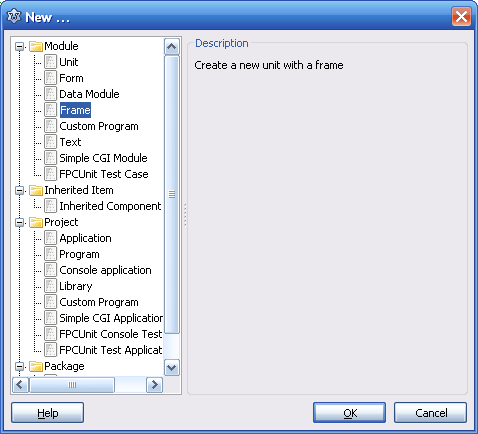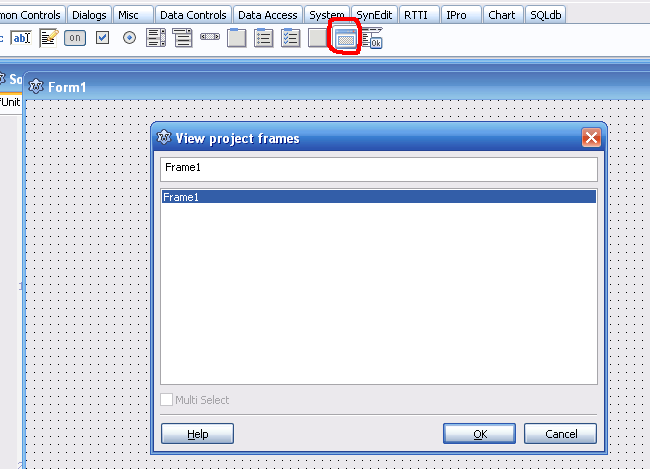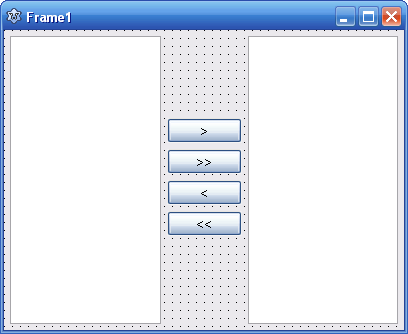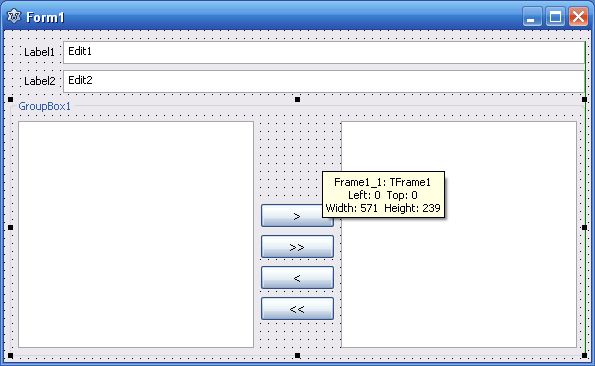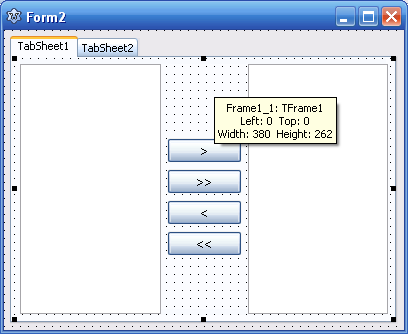Frames
│
Deutsch (de) │
English (en) │
suomi (fi) │
русский (ru) │
TFrames are named containers for components and very similar to forms. Their unique ability is that they can be embedded into forms or other frames in the designer. As forms they are stored in two files: the code is stored in .pas file and the design in the .lfm file.
How to create a frame?
Press File->New... menu item and in the opened dialog select "Frame" item.
How to place a frame to the form or another frame?
The Standard tab of the Component Palette has a special component item "TFrame". When you add it to the form the IDE asks you to choose one of the project's frames. You really have to click the frame component in the toolbar and "click it" down on your form first (drag&drop won't work) - the selection dialog will only appear afterwards not upon just clicking the component icon. You have to save the project and the the new frame first, only saved frames will appear in the choose from list. Frames in packages are not yet implemented. But you can create frames in code even in packages. You can't create frame circles - the IDE will forbid this, i.o.w. you can't place FrameA to FrameA and you can't place any frame which contains FrameA to FrameA.
What can they be used for?
They are needed when you have a group of components that you want to reuse on multiple forms. The group should have the same set of controls and logic between them at different windows (forms) of your application. You can group that repeated controls and logic into one frame and use that frame in different places. Therefore you don't need to repeat the work of control layouting and writing their logic.
For example, you have two listboxes and buttons to move items between them. So you can create a frame with two listboxes and needed buttons, write the logic for items moving and then use your frame on all forms where needed. Moreover, if you find an error in the frame code then you can fix it once in the frame code instead of fixing it n-times among all forms.
a frame in designer:
the frame placed on a form:
the same frame placed on another form:
Initialising private variables
TFrame does not have OnCreate or OnDestroy events in which private variables can be initialised and released. Override the default constructor and destructor to do this.
TFrame1 = class(TFrame)
private
MyObj: TObject;
public
constructor Create(TheOwner: TComponent); override;
destructor Destroy; override;
end;
constructor TFrame1.Create(TheOwner: TComponent);
begin
inherited Create(TheOwner);
MyObj := TObject.Create;
end;
destructor TFrame1.Destroy;
begin
MyObj.Free
inherited Destroy;
end;
Sample of dynamic creation
More easy. Because TFrame component in component palette is not required. And you can make a page change type application(like a smart phone application) with save resource.
unit Unit1;
{$mode objfpc}{$H+}
interface
uses
Classes, SysUtils, FileUtil, Forms, Controls, Graphics, Dialogs, StdCtrls;
type
{ TForm1 }
TForm1 = class(TForm)
Button1: TButton;
GroupBox1: TGroupBox;
procedure Button1Click(Sender: TObject);
procedure FormCreate(Sender: TObject);
private
{ private declarations }
Frame: TFrame;
public
{ public declarations }
end;
var
Form1: TForm1;
implementation
uses
Unit2{TFrame1}, Unit3{TFrame2}, Unit4{TFrame3};
{$R *.lfm}
{ TForm1 }
procedure TForm1.FormCreate(Sender: TObject);
begin
Frame := TFrame1.Create(GroupBox1);
Frame.Parent := GroupBox1;
end;
procedure TForm1.Button1Click(Sender: TObject);
begin
if not Assigned(Frame) then
begin
Frame := TFrame1.Create(GroupBox1);
Frame.Parent := GroupBox1;
end else if Frame is TFrame1 then begin
Frame.Free;
Frame := TFrame2.Create(GroupBox1);
Frame.Parent := GroupBox1;
end else if Frame is TFrame2 then begin
Frame.Free;
Frame := TFrame3.Create(GroupBox1);
Frame.Parent := GroupBox1;
end else begin
FreeAndNil(Frame);
end;
end;
end.
